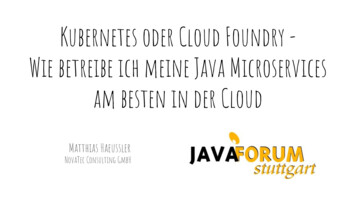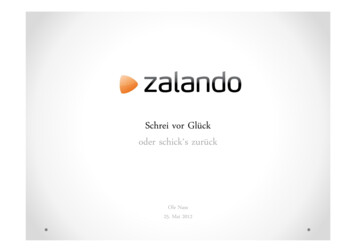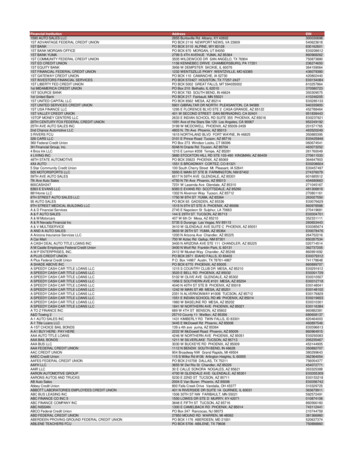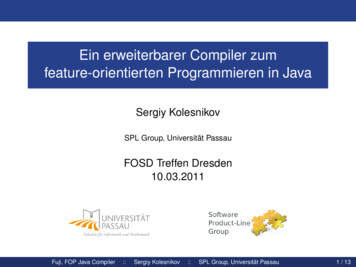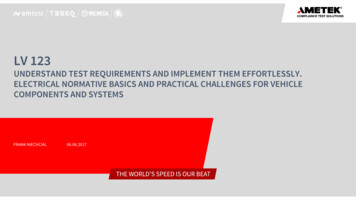
Transcription
LV 123UNDERSTAND TEST REQUIREMENTS AND IMPLEMENT THEM EFFORTLESSLY.ELECTRICAL NORMATIVE BASICS AND PRACTICAL CHALLENGES FOR VEHICLECOMPONENTS AND SYSTEMSFRANK NIECHCIAL06.06.2017
CONTENTS Electrical requirements and tests of LV 123Electrical Characteristics and Electrical Safety of High-Voltage Components in Road Vehicles Terms and definitionsElectrical requirements and tests of HV componnets Definition: LV123 is a harmonized document of test requirements of all German OEMs: Audi, BMW, Daimler, Porsche and VW Advantages: Systematic approach and transparent definition of test parameter Possibility of interchanging qualification results Comparability of product qualifications, even across OEM borders
OVERVIEW LV 123 STANDARDS LV 123 Electrical Characteristics and Electrical Safety of High-Voltage Components in Road Vehicles Requirements and Tests BMWGS 95023Edition: 2016-11 MercedesMBN LV 123Edition : 2014-03 Volkswagen VW 80303Edition : 2014-06
OVERVIEW HV SYSTEM The HV system of a vehicle with an electric drive system consists of several HV components.Operating voltagesDC: 60 V - 1500 VAC: 30 V - 1000 V(rms)
HV – OPERATING STATUS The HV operating status apply to HV components.HV StatusDescription of HV – operating statusB0The HV components are operational and there is no power demand.B1The HV components are fully operational, and provide their intended performance.B2The HV components are still fully operational.The HV components provide a performance within the deviations permissible for operating status B2.When the HV components revert to operating status B1, they shall automatically provide their intended performance.B3The HV components are still operational, shall not assume any undefined states and, in particular, shall not cause any malfunctions in otherHV components.- The HV components may reduce their output for self-protection purposes.- When the HV components revert to operating status B1 or B2, they shall automatically provide their intended performance.B4The HV components are still operational and shall not assume any undefined states.- The HV components may switch off their output.- When the HV components revert to operating status B1, B2 or B3, they shall provide their intended performance by means of a reset or asimple intervention (e.g. change of ignition status, restart vehicle).Table 2: HV operating status
HV – VOLTAGE RANGESThe HV- voltage ranges are represented with the following four voltage ranges.HV- operatingrangeUnitHV 1HV 2aHV 2bHV 3Overvoltage at load dumpB3 / B4V pk220410500800Upper HV circuit limit voltageB3 / B4V pk220410500800Maximum operating voltageB2V d.c.200360470770Upper limited operating capabilityB2V d.c. 190-200 340-360 450 - 470 750 - 770Unlimited operating capabilityB1V d.c.90 - 190170 - 340250 - 450520 - 750Lower limited operating capabilityB2V d.c.80 - 90160 - 170200 - 250450 - 520Highly limited operating capabilityB2 a / B3 bV d.c.60 - 80120 - 160150 - 200-B3V d.c.0 - 600 - 1200 - 1500 - 450HV- voltage rangesUndervoltageTable 3: HV voltage ranges
DYNAMIC PARAMETERS (TABLE 4) The change of the DC HV circuit voltage over time shall be limited to the specified maximum generated voltagedynamics (slope) for every HV component that is controlled by power electronics; see Table 4 "Dynamic parameters".The requirement shall be fulfilled for all HV operating statuses in accordance with Table "HV operating status".ParameterUnitHV 1HV 2aHV 2bHV 3Generated voltage dynamics (slope) between two differentsteady-state voltage levels (holding time 2 s), robustnessduring operation in DC HV circuit (i.e. operating voltagewithout ripple)V/ms 15 15 15Present voltage dynamics (slope) between two differentsteady-state voltage levels (holding time 2 s), robustnessduring operation in DC HV circuit (i.e. operating voltagewithout ripple)V/ms 20 20 20Present and generated voltage ripple withHV battery switched on (at specified continuous output)Vpk 8 8 8Present and generated voltage ripple withHV battery switched off (at specified continuous output)Vpk 15 15 15Table 4: Dynamic parameters
LOAD DUMP AND VOLTAGE LIMITING (TABLE 5) HV components shall meet the HV operating status B3 or B4 in accordance with table 4"HV operating status" in the event of overvoltage due to load dump. See OEM's requirements documentation forinformation on the HV operating status.Further, HV components shall be designed for the maximum voltage dynamics in accordance with table 5 "Maximumvoltage dynamics" in the event of overvoltage due to load dump. The respective HV component shall detect the occurrence of load dump and initiate the measures for voltage limiting.ParameterMaximum voltage dynamics(slope), load dumpHV - operatingstatusUnitHV 1HV 2aHV 2bHV 3B3V/ms 250 250 250Table 5: Maximum voltage dynamics
10TESTS OVERVIEW HV System voltage rangeThe tests are based on the requirements for HV components with regard to their electric behavior in DC HV circuits; see Section 6"Electrical operating ranges of the HV system"./ Product validationThe tests apply to the operation of the HVcomponents in HV circuits and to electricalsafety for vehicles with HV systems./ 100% standard production testingTable 20: Tests regarding the voltage ranges of the HV system
10TESTS Electrical characteristics and HV safetyThe tests are based on the requirements regardingelectrical characteristics and electrical safety for HVcomponents in accordance with Section 7 "Requirementsfor electrical characteristics and HV safety".Xp: Test scope for product validationXs: Test scope for 100% standard production testTable 22:Tests regarding el. characteristicsand HV safety for HV components
10TESTS Additional requirements for individual HVcomponentsThe tests are based on the requirements for HVcomponents in accordance with Section 8 "Additionalrequirements for individual HV components". Additional requirements for connection to an externalelectric voltage supplyThe tests are based on the additional requirements for HV components inaccordance with Section in accordance with Section 9 "Additional requirements forthe connection to an ext. el. Power supply".Table 23: Tests regarding additional requirements for connection to anexternal electric power supplyTable 22: Tests regarding the additional requirements for HV componentsXp: Test scope for product validationXs: Test scope for 100% standard production test
STANDARD VALUES Unless otherwise specified, the values in accordance with Table 26 "Standard values“ shall be selectedTest parameterValueRoom temperatureHumidityAmbient test temperatureInternal resistance HV voltage source (Ri)LV voltage for testTRT 23 C 5 CFrel 25 % to 75 % RHTRTRi 100 mOhm14 V / 28 VTable 26: Standard valuesThe sampling rate and bandwidth and resolution of the measuring system shall be adapted for the respective test.All measured values with all maximum values (peaks) shall be recorded.
STANDARD TOLERANCES Unless otherwise specified, the tolerances in accordance with Table "Standard tolerances" apply. Tolerances ofenvelopes must always be considered unilaterally as otherwise the requirement is mitigated. Voltage - up to 1000 V DC to 1 kHz: 1 kHz to 5 kHz: 5 kHz to 20 kHz: 20 kHz and above: - 1000 V und and above DC to 20 kHz: 20 kHz and above: 1,5 % 2,0 % 3,0 % 5,0 % Power (50/60 Hz) to 1 W: above 1 W and to 3 kW: above 3 kW: 20,0 mW 3,0 % 5,0 % Resistance 1 mOhm to 100 mOhm: 1 MOhm to 1 TOhm: above 1 TOhm: All others: 5,0 % 5,0 % 10,0 % 3,0 % Temperature below100 C: 100 C to 500 C: 2,0 C 3,0 % Time 10 ms to 200 ms: 200 ms to 1 s: 1 s and above: 5.0 % 10,0 ms 1,0 %Relative Humidity 30 % to 95 % RH: 6,0 % RH 3,0 % 5,0 %Current - up to 5 A AC to 60 Hz: 1,5 % 60 Hz to 5 kHz: 2,5 % 5 kHz to 20 kHz: 3,5 % 20 kHz und and above: 5,0 % - 5 A and above DC to 5 kHz: 2,5 % 5 kHz to 20 kHz: 3,5 % 20 kHz and above: 5,0 %
TEST SETUP LV 123 does not provide detailed specifications for the test set-up for HV test components. In general it is required thatthe test set-up is to be documented in detail with all its components. The standard VW 80300 describes the same tests as LV 123, with further helpful hints for the test setup.HV Test setup Type 1 for slow eventsHV Test setup Type 2 for fast events
TEST SETUP DC SOURCE AC / DC sources with recuperation properties are suitable for testing HV components. Thus, the source is also able toabsorb energy from the device under test by means of regenerative energy. For voltage levels above 500 V, it ispossible to double the DC voltage with two phases. The sources are potential-free against the ground, which must betaken into account during the test setup and the measurements.Setup for a 3-phase source for DC applicationsAC / DC source Netwave 3-ph SerieSetup for HV 1, HV 2Setup for HV 3
NETWAVE 3-PHASE: NEW DATASHEET
NETWAVE OPT DC-EVR : DC EXTENDED VOLTAGE RANGE OPTION
NEW: NETWAVE 20.3 / 30.3 / 60.3 / 90.3
NEW: NETWAVE 270.3
10.4.1 TEST RANGE OF UNLIMITED OPERATING CAPABILITY Requirement:see section 6.3.3.2 "Range of unlimited operating capability" Test type:Product validation, 3 cycles, 3 samples Test method:MeasurementHV 1HV 2aHV 2bHV 3Maximum value190 V340 V450 V750 VUnlimited operatingcapability140 V255 V350 V635 VMinimum value90 V170 V250 V520 VFor HV 1 a: 90V, b: 190V - c 140VThe slopes are in the ms range,tr1, tr2: 3.33ms, tf1: 6.66ms
10.4.2 TEST RANGE OF UPPER LIMITED OPERATION Requirement:see section 6.3.3.3 "Range of upper limited operating capability" Test type:Product validation, 3 cycles, 3 samples Test method:MeasurementHV 1Maximum valueUpper limitedoperating capabilityMin. / Max. valueUnlimited operatingcapabilityMinimum valueHV 2aHV 2bHV 3200 V360 V470 V770 V195 V350 V460 V760 V190 V340 V450 V750 V140 V255 V350 V635 V90 V170 V250 V520 VFor HV 2 a: 170V, b: 340V - c 255Vd: 360V - e 350Vtr1: 5.66ms, tr2, tf1: 1min
10.4.3 TEST RANGE OF LOWER LIMITED OPERATING CAPABILITY Requirement:see section 6.3.3.4 "Range of lower limited operating capability" Test type:Product validation, 3 cycles, 3 samples Test method:MeasurementHV 1HV 2aHV 2bHV 3Maximum value190 V340 V450 V750 VUnlimited operatingcapability140 V255 V350 V635 V90 V170 V250 V520 V85 V165 V225 V485 V80 V160 V200 V450 VMin. / Max. valueLower limitedoperating capabilityMinimum value
10.4.4 TEST RANGE OF HIGHLY LIMITED OPERATING CAPABILITY Requirement:see section 6.3.3.5 "Range of highly limited operating capability" Test type:Product validation, 3 cycles, 3 samples Test method:MeasurementHV 1Maximum valueUnlimited operatingcapabilityMin. / Max. valueLower limitedoperating capabilityMin. / Max. valueHighly limitedoperating capabilityMinimum valueHV 2aHV 2bHV 3190 V340 V450 V750 V140 V255 V350 V635 V90 V170 V250 V520 V85 V165 V225 V485 V80 V160 V200 V450 V70 V140 V175 V-60 V120 V150 V-
10.4.5 TEST VOLTAGE DYNAMICS Requirement:see section 6.3.4.2 “Voltage dynamics" Test type:Product validation, 10 cycles, 3 samples Test method:MeasurementIt shall be verified that the HV operating status of the HV componentin the respective operating voltage range does not change due togenerated voltage dynamics (slope). Test Generated voltage dynamicsCompliance with the maximum generated/present voltagedynamics (slope) shall be verified for all operating modes.The test pulse in accordance with Figure 19 "Test pulse generatedvoltage dynamics" and the specifications for voltage dynamics in Table4 "Dynamic parameters“ shall be used.Figure 19 Test pulse generated voltage dynamicsGenerated voltage dynamics (slope) between twodifferent steady state voltage levels (holding time 2s), generated by individual HV component:Value: /- 15 V/ms for HV 1, HV 2a/b and HV 3
10.4.5 TEST VOLTAGE DYNAMICS Requirement:see section 6.3.4.2 “Voltage dynamics" Test type:Product validation, 10 cycles, 3 samples Test method:Measurement Present voltage dynamicsThe test shall be verified in HV operating mode B1, B2, B3Robustness with regard to the maximum present voltagedynamics (slope) shall be verified for all HV components bymeans of appropriate measurements. The specifications forthe voltage dynamics in Table 4 "Dynamic parameters" shallbe used.It shall be verified that the HV operating status of the HVcomponent in the respective operating voltage range does notchange due to present voltage dynamics (slope).Generated voltage dynamics (slope) between twodifferent steady state voltage levels (holding time 2 s),generated by individual HV component:Value: /- 20 V/ms for HV 1, HV 2a/b and HV 3
10.4.6 TEST VOLTAGE RIPPLE Requirement:see section 6.3.4.3 “Voltage ripple" Test type:Product validation, 1 cycles, 3 samples Test method:MeasurementAll HV voltage operatingranges HV 1, HV 2a/2b, HV 3ParameterPresent and generatedVoltage ripple with HV battery switched on 8 V pk Test generated voltage rippleFor every HV component controlled by power electronics, evidence shall beprovided that the generated voltage ripple in HV system operation with andwithout HV battery (switching equipment HV battery switched on and off) inaccordance with Table 4 "Dynamic parameters" is fulfilled.The frequency response shall be documented by the supplier.The test set-up shall be documented in detail, including line inductances, linecapacitances, on-board electrical system equivalent capacitances and lineresistances.HV ComponentDC/ DC-converter HV/LVDrive system power electronicsOn-board charger,Other HV component, HV batteryOperating modeBoost Mode / Buck ModeEngine- / Generator modeHV-System (ext. el. Power supply)Load mode
10.4.6 TEST VOLTAGE RIPPLE Requirement:see section 6.3.4.3 “Voltage ripple" Test type:Product validation, 1 cycles, 3 samples Test method:Measurement Test generated voltage rippleFor every HV component, robustness and stab
TEST SETUP LV 123 does not provide detailed specifications for the test set-up for HV test components. In general it is required that the test set-up is to be documented in detail with all its components. The standard VW 80300 describes the same tests as LV 123, with further helpful hints for the test setup.
